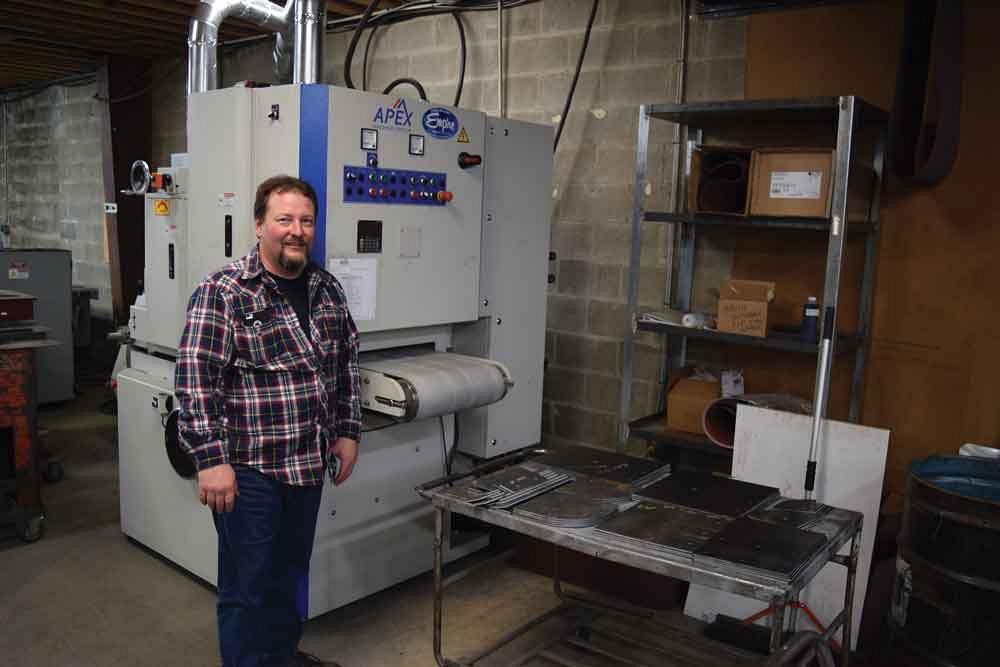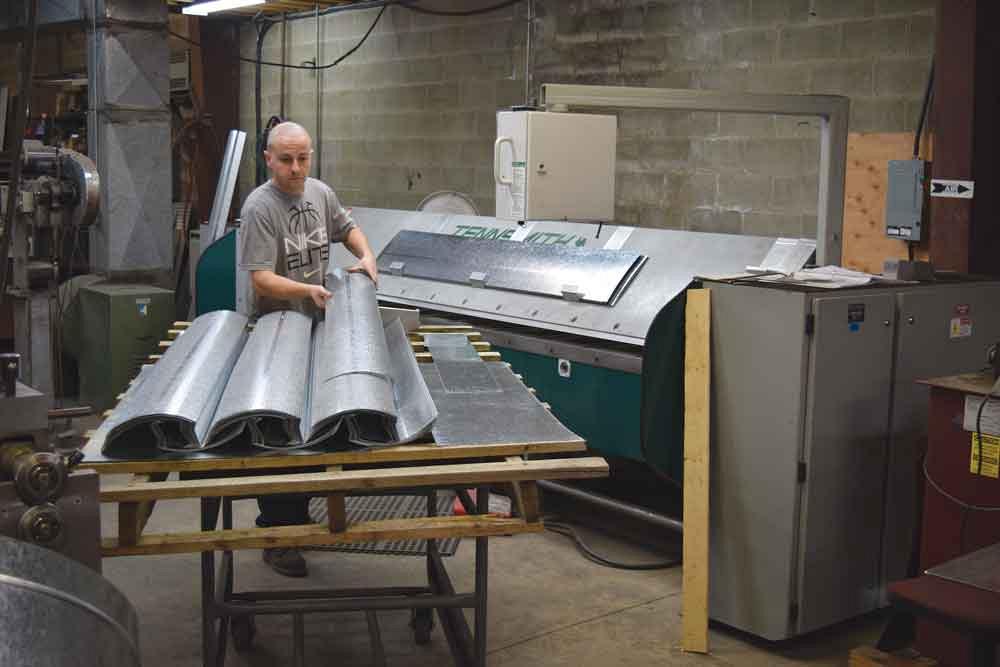Editor
- FMA
- The Fabricator
- FABTECH
- Canadian Metalworking
Business Profile: L.J. Custom
Automated deburring machine opens up opportunities for larger part runs at L.J. Custom
- By Rob Colman
- July 1, 2016
- Article
- Fabricating
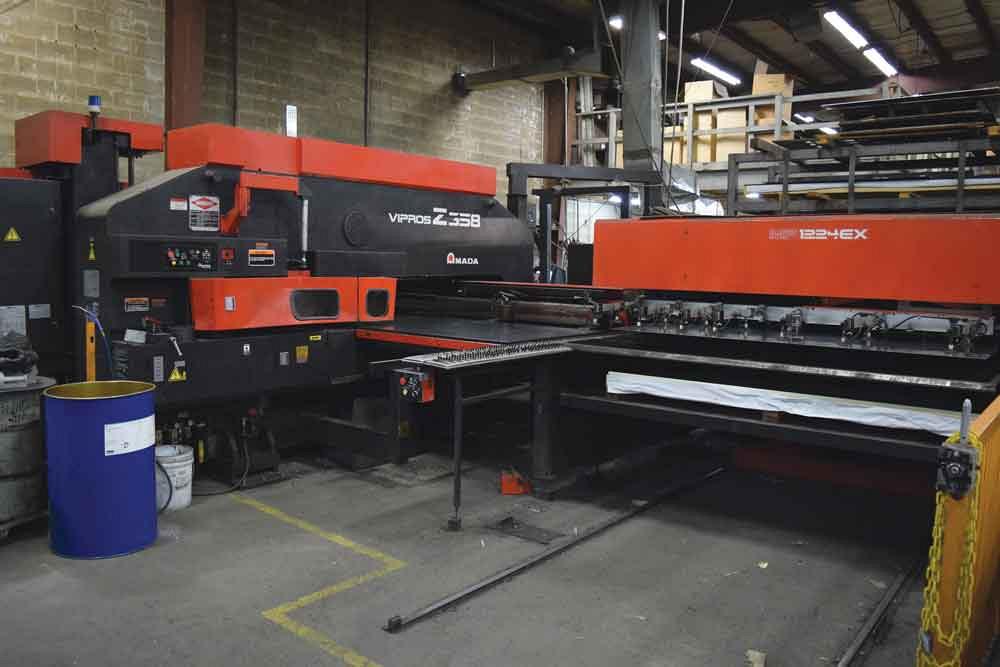
L.J. Custom’s Amada Vipros Z358 with sheet loader, which runs lights-out nights and weekends when needed.
Reducing man-hours on any job can make the difference between landing a contract and losing out to a competitor properly geared for the parts in question. Surrey, B.C.-based L.J. Custom Sheet Metal understands this only too well, which is why, over its 32-year existence, the fabricating company has made critical upgrades to match the demands of its clients. Most recently this has included a new deburring machine, a new press brake, and a folding machine.
History
L.J. Custom was founded by husband and wife team Larry and Joan Oster. Originally the shop specialized in serving the ductwork and ventilation equipment market, but it has since become a go-to shop for a variety of jobs for a broad swath of industries, including HVAC, logging and fireplace construction. When Canadian Fabricating & Welding visited the shop, L.J. Custom was working on wall brackets, louvres for ventilation on buildings, and fireplace parts, to name just a few.
“We stand out through the variety of jobs we can handle,” said General Manager John Mattern. Mattern started with the shop 25 years ago as a welder. “We have plasma cutters, CNC punch presses, press brakes, plate rolling and roll forming capabilities, and shears. Although we are not a large shop, we can handle big jobs. With our welding talent, we can also handle assembly work.”
The team of 16 in the L.J. shop includes three welders. They work in mild steel, galvanized, stainless, and aluminum in sheet thicknesses from 30 gauge to ½-inch-thick plate.
The owners have always believed in making strategic machinery investments that fit the shop’s niche market. For instance, L.J. Custom had one of the first CNC plasma cutters in British Columbia, a 5- by 20-ft. table that is still used, even though the company has a high-definition, 6- by 10-ft. Messer plasma table that will cut up to ½-in. plate.
Punch Press, Deburring Combo Benefts
It’s the shop’s CNC punch presses that probably add the most production capacity in comparison to man-hours employed. Its Amada Vipros Z358 turret punch press is equipped with a sheet loader, which allows for lights-out production. L.J. Custom has devised a camera system that allows the team to check on the machine after hours using mobile devices.
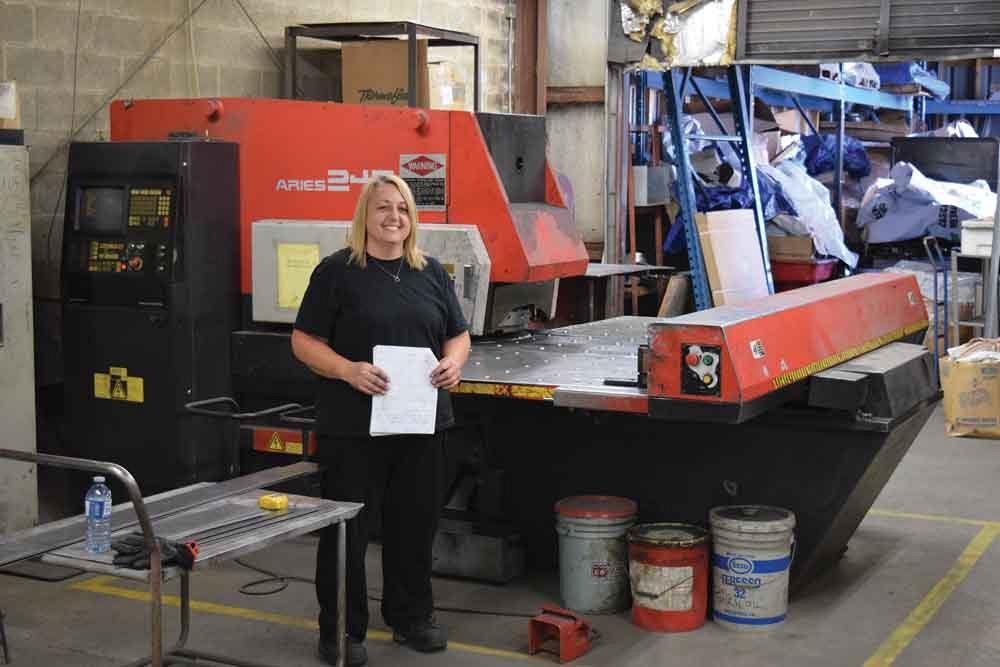
Lisa Oster in front of the shop’s Amada Aries 245, which is situated right next to the new Apex deburring machine for the rapid processing of parts.
“Even before we had the camera system, we had this running all night,” noted Mattern. “However, someone would have to come in periodically to check that there were no concerns.”
A second CNC punch press, the Amada Aries 245, is used primarily for rush jobs. However, the new Apex deburring machine the shop has purchased is making production work on that table more appealing. A 19-in. Apex 1975M-DM model was installed right next to the punch press on the shop floor. This deburring machine is a two-station model, meaning the first process the material goes through is a 19- by 75-in. abrasive belt sanding head, followed by a 20-in.-diameter Scotch-Brite™ pad running in dry operation. Each station have has its own dust hood positioned to collect debris in a wet dust collector.
The conveyor feed speed can be adjusted from 5 to 25 ft. per minute. The first sanding head is powered by a 20-HP motor and the second by a 5-HP motor. The height for each sanding head can be adjusted independently. The thickness setting for the conveyor is motor-driven and comes with a digital programmable keypad. Up to 10 thickness presets can be stored in the system.
“We bid on a job that we had done before, however, the number of parts to be produced is about four times what we did the last time we got this contract,” said Mattern. “The part requires burrs to be removed. It will be a lot of small parts. By investing in a deburring machine, we’ll likely halve the time we spend on the job.”
The deburring machine, on the floor since February, has already saved time on a number of short runs, but it will be in larger job runs of small parts that the benefits of the investment will really become apparent. On fiddly small parts, automating the deburring process just makes sense, said Mattern.
Long production runs are nothing new to L.J. Custom. Mattern said their jobs range from 100 to 10,000 parts at a time. Keeping his team working on production rather than finishing frees up time for value-added applications.
Press Brake Options
Although the shop has a 14-ft., 250-ton press brake, six months ago it invested in a much smaller Accurpress Advantage press brake (an 8-ft., 100-ton machine). With its small footprint, Mattern said, the new brake makes sense for many of the smaller parts the shop is producing, saving both time and money.
“Accurpress is right in town [in Surrey] and they make the presses right here, which is why we bought them,” said Mattern. “We have no concerns if we need service.”
The other recent investment the company has made is a Tennsmith CNC folder. The folder is ideal for long panel work for which the setup time on a press brake would be unnecessarily complicated. The speed of the operation on repetitive, large parts was on display during CF&W’s visit, at which time one of the team members was bending a perforated profile.
It’s obvious L.J. Custom is still very much a family business. The Osters’ daughter, Lisa, is a key contributor on the shop floor. And management encourages the team to continually upgrade their skills through courses outside the shop and training within. That comes back to the shop’s goal, which is to be the go-to local supplier for whatever its customers can dream up.
Editor Robert Colman can be reached at rcolman@canadianfabweld.com.
L.J. Custom Sheet Metal Ltd., 604-574-5330, www.ljcustomsheetmetal.com.
About the Author

Rob Colman
1154 Warden Avenue
Toronto, M1R 0A1 Canada
905-235-0471
Robert Colman has worked as a writer and editor for more than 25 years, covering the needs of a variety of trades. He has been dedicated to the metalworking industry for the past 13 years, serving as editor for Metalworking Production & Purchasing (MP&P) and, since January 2016, the editor of Canadian Fabricating & Welding. He graduated with a B.A. degree from McGill University and a Master’s degree from UBC.
subscribe now


Keep up to date with the latest news, events, and technology for all things metal from our pair of monthly magazines written specifically for Canadian manufacturers!
Start Your Free Subscription- Trending Articles
Class is in session for college connections
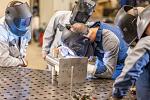
BlueForge Alliance partners with Nuts, Bolts & Thingamajigs to develop Submarine Manufacturing Camps

Portable system becomes hot tech in heat treatment

Orbital tube welding webinar to be held April 23

Cidan Machinery Metal Expo 2024 to be held in Georgia May 1-2

- Industry Events
MME Winnipeg
- April 30, 2024
- Winnipeg, ON Canada
CTMA Economic Uncertainty: Helping You Navigate Windsor Seminar
- April 30, 2024
- Windsor, ON Canada
CTMA Economic Uncertainty: Helping You Navigate Kitchener Seminar
- May 2, 2024
- Kitchener, ON Canada
Automate 2024
- May 6 - 9, 2024
- Chicago, IL
ANCA Open House
- May 7 - 8, 2024
- Wixom, MI













